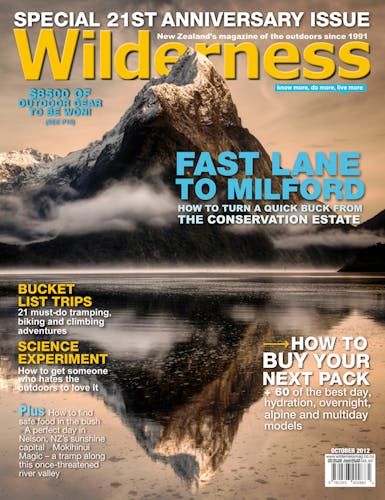Who would have thought that a magazine all about tramping would prove to be one of the biggest – and not to mention most awarded* – sport and leisure magazines in New Zealand? That certainly wasn’t on the cards back in 1991 when Wilderness was launched. This October issue, though, marks the 21st anniversary of Wilderness – a huge milestone for any magazine, let alone a niche title about a niche sport.
Right from the very first issue, Wilderness struck a chord with the outdoor community. After just two issues – October/November and December/January –demand for the magazine had reached a point where it was feasible to print it monthly. It’s been printed that way ever since with this issue being number 251.
Over the years, Wilderness has stood side-by-side with outdoors people as it became the mouthpiece of trampers who have shared trips, advice and the outdoors with us and the magazine’s readers.
On p54, roving editor Shaun Barnett charts some the major gains trampers have achieved over the years and which Wilderness has chronicled: new national and conservation parks, better huts and tracks and a wilder experience as introduced pests have been brought under control and native birds begin to flourish.
But, sadly, history repeats and the battles faced by earlier generations of trampers have come full circle as mining and energy companies once again threaten protected public lands all in the name of GDP and we are once again faced with the spectre of open cast mines and hydro dams making a mockery of the laws protecting the conservation estate.
Proposals that threaten to desecrate a World Heritage Area in order to speed visitors from Queenstown to Milford Sound are the latest in a seemingly endless assault on New Zealand’s wilderness areas. So, as well as looking back over the recreation and conservation successes of the past 21 years, we thought it appropriate to investigate the Milford-Dart tunnel and Snowden Forest monorail projects (p36). Anyone who knows of the blood, sweat and tears shed in the fight to establish national parks like Paparoa, to prevent destructive logging of native trees and the damming of wild rivers, will shake their heads in dismay at these proposals. No matter how hard you fight, no matter the victories you gain, it seems nothing is forever and the status of a national, forest or conservation park is wholly at the whim of the government of the day.
If concessions for the Milford projects are granted, it will not only be a slap in the face to all those who laboured to create national park management plans, there’s a good chance the very reason tourists visit the area – its World Heritage status – will be revoked. We can also expect greater pressure for similar developments on other protected public lands to be given the go-ahead.
Wilderness’s 21st anniversary is a great milestone, but only made possible by the wonderful outdoor recreation opportunities found in this country. On that note, I would like to offer a special thanks to all our readers – past and present – who have followed Wilderness these past two decades, shared their outdoor adventures and contributed to making the magazine such a valuable part of the New Zealand outdoor scene. We wouldn’t be celebrating 21 years without you.







